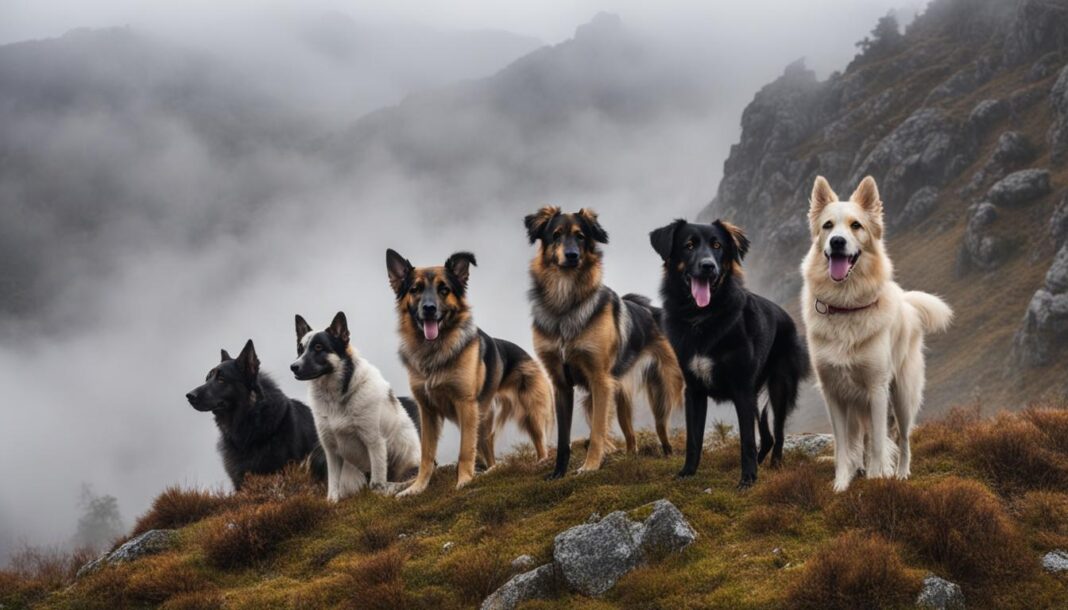Welcome to your ultimate guide of dog breeds in Spanish, featuring a comprehensive list of the most popular and unique Spanish dog breeds originating from Spain and Latin America. With a focus on revealing the meanings behind these distinct Spanish dog breeds names, we believe that every canine enthusiast, pet owner, or just someone curious about Spanish dog names, deserves a resource that goes beyond the ordinary and helps their furry friend stand out from the pack. This is the perfect place to embark on your journey of personalizing your pet’s identity while learning about the rich cultural significance of these names and how they reflect both the animals and their caregivers.
Embracing Spanish Culture: Unveiling the Importance of Dog Names
In the Spanish-speaking world, the importance of dog names holds considerable cultural significance, reflecting the personality of both the animal and its owner. Dogs are often viewed as esteemed family members in Spanish culture, and as such, choosing a dog’s name is a careful and thoughtful process. This section will help you understand the ins and outs of selecting a Spanish name for your furry friend, regardless of their breed.
Spanish dog names can comprise of feminine and masculine nouns, names associated with different dog colors, and names that convey specific meanings, such as hope, love, and strength. By understanding the various aspects of Spanish culture and dogs, you will be better equipped to choose a name that captures your pet’s appearance or character.
- Feminine dog names: Examples of popular feminine Spanish dog names include Lola, Isabella, and Carmen.
- Masculine dog names: Examples of popular masculine Spanish dog names include Paco, Diego, and Carlos.
- Names for different dog colors: Examples include Blanco (white), Negro (black), and Dorado (golden).
- Names with specific meanings: Examples include Esperanza (hope), Amor (love), and Fuerza (strength).
When choosing a dog’s name, it’s essential to consider how that name will reflect and embody the essence of your pet. A Spanish name can be appropriate for any breed, aiming to capture the pet’s appearance or character, and provide a unique and culturally significant identity for them.
So, whether you are bringing home a new pet or want to understand more about your neighbor’s dog, this guide offers fascinating insights into the Spanish cultural practice of naming dogs. By embracing the spirit of Spanish culture in the naming process, you ensure that your beloved pet is given an exceptional moniker befitting their place in your home and heart.
The Unique Charm of Spanish Breed Dogs
Traditional Spanish dog breeds, such as the Chihuahua, Spanish Mastiff, Catalan Sheepdog, and others, each possess distinct characteristics that are enshrined in their breed names. From their rich cultural history to their captivating features, these breeds hold a special place in the hearts of dog enthusiasts around the world. In this section, we will explore the various traditional Spanish dog breeds, their significance within the cultural context, and the fascinating origin stories of these native canines.
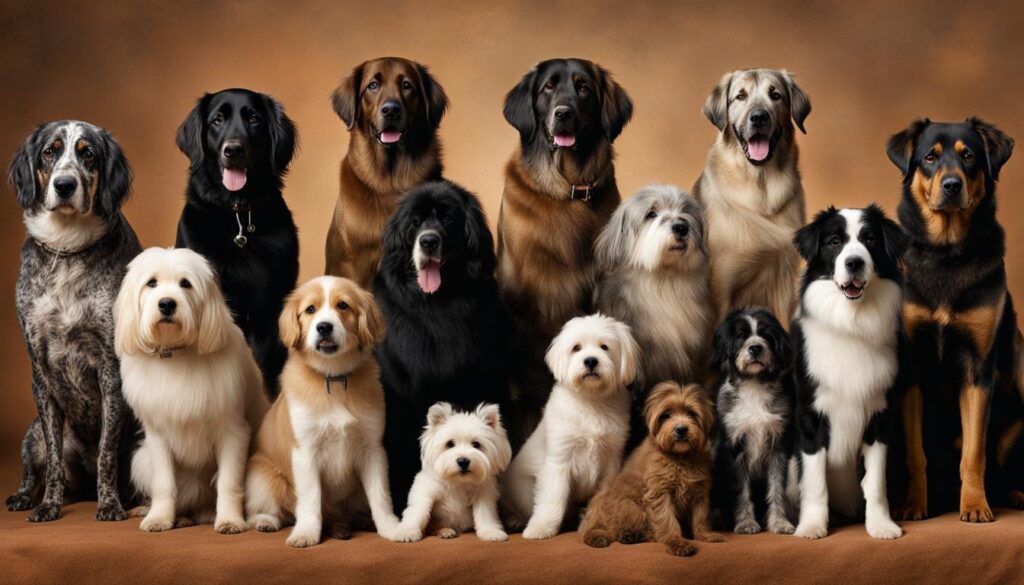
Identifying Traditional Spanish Dog Breeds and Their Characteristics
Several traditional Spanish dog breeds exhibit unique features and carry distinct names that align with their traits. Three of the most famous Spanish breed dogs include:
- Chihuahua: Small and lively, these dogs are known for their loyalty and charming personalities.
- Spanish Mastiff: A large and powerful breed, they are renowned for their guarding abilities and gentle temperament, especially with their family.
- Catalan Sheepdog: Originally bred for herding, these intelligent and adaptable dogs form strong bonds with their owners and are ideal companions for an active lifestyle.
Why Spanish Breed Dogs Matter: A Cultural Perspective
Spanish breed dogs hold immense cultural significance, with many easily recognized breeds hailing from various regions of Spain. These dogs have not only played important roles in the nation’s history but have also become an integral part of its cultural heritage. Understanding the cultural relevance of these breeds provides a deeper appreciation for their names and the stories they carry. For instance, the Spanish Mastiff is highly regarded as a protector in Spanish culture, symbolizing strength and loyalty.
Exploring the Origin Stories of Spain’s Native Canines
Diving into the origin stories of Spain’s native dog breeds reveals that these cherished canines have played a myriad of roles in the past, from noble hunting companions to loyal herding dogs. These rich histories have influenced both the naming and perception of each breed in Spanish society. Here are three examples:
| Breed | Origin Story | Cultural Significance |
|---|---|---|
| Chihuahua | Originating in Mexico, they were believed to have healing abilities and were often used in spiritual rituals. | Known for their mystical nature and small stature, the Chihuahua’s name reflects its unique history and close connection with ancient culture. |
| Spanish Mastiff | Used by shepherds to protect livestock, these dogs were also trusted to secure homes and property. | This breed’s name highlights its long-held status as a reliable guardian in Spanish culture. |
| Catalan Sheepdog | Developed in Catalonia, these herding dogs were invaluable assistants to farmers and shepherds. | The Catalan Sheepdog’s heritage as a hardworking and loyal companion is reflected in its breed name. |
As we can see, the many traditional Spanish dog breeds, their characteristics, and their names hold immense cultural significance. Delving into their origin stories and sociocultural contexts helps us understand and appreciate the charm and allure of Spanish breed dogs, making them an ideal choice for pet owners who want a unique, meaningful connection with their canine companions.
Top Dog Breeds in Spain and Their Spanish Monikers
Spain is home to a wide variety of popular dog breeds, each with unique characteristics and features. Some of these dogs are native to Spain, while others have been embraced and thoroughly integrated into the Spanish lifestyle. To appreciate these beautiful animals, we will explore their distinctiveness alongside their Spanish names, which often reflect their personalities and physical attributes.
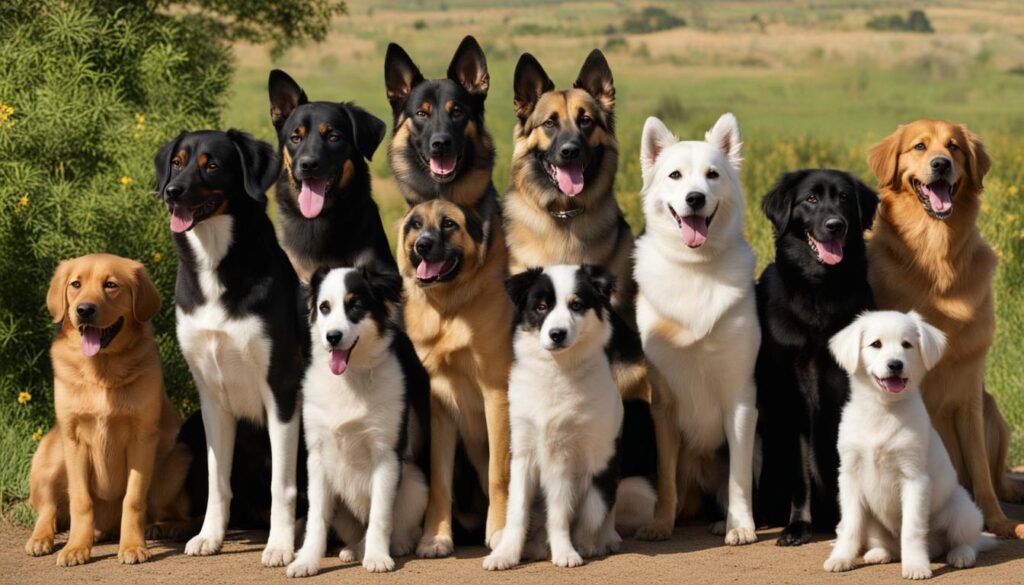
- Pomeranian (Pomerania): Known for their fierce loyalty to their owners, these small yet brave dogs are perfect companions. The Spanish name “Pomerania” captures their noble origins and spirited nature.
- German Shepherd (Pastor Alemán): German Shepherds are highly intelligent, agile, and obedient. Their strength and discipline make them excellent working dogs, and their Spanish moniker, “Pastor Alemán,” pays homage to their German lineage and herding abilities.
- Labrador Retriever (Labrador Retriever): Known for their affectionate nature and playful energy, Labradors hold a special place in many Spanish households. The Spanish name simply mirrors the English name, emphasizing their widespread popularity and appeal.
In addition to these top dog breeds in Spain, there are many other beloved canines with unique Spanish monikers. Some examples include:
| Dog Breed | Spanish Name | Brief Description |
|---|---|---|
| Golden Retriever | Golden Retriever | Known for their friendly nature and beautiful golden coat, these dogs are also popular in Spain, with the Spanish name reflecting their English counterpart. |
| Boxer | Boxer | Boxers are strong and energetic dogs that make great family pets. Their Spanish moniker, “Boxer,” mirrors their English name, highlighting their international appeal. |
| Yorkshire Terrier | Yorkshire Terrier | These small yet elegant dogs are beloved for their affectionate and loyal qualities. The Spanish name, “Yorkshire Terrier,” signifies their roots in England, a testament to their worldwide popularity. |
As evident from the examples, popular dog breeds in Spanish households often have names that mirror their English or international counterparts. This reflects the extent to which these breeds have been embraced in Spain and the shared values that pet owners across the globe uphold. By understanding the Spanish monikers for these top dog breeds in Spain, pet lovers can further appreciate the unique characteristics and cultural ties that shape our furry friends’ identities.
Spanish Dog Breeds Beyond Borders: Popular Breeds in Latin America
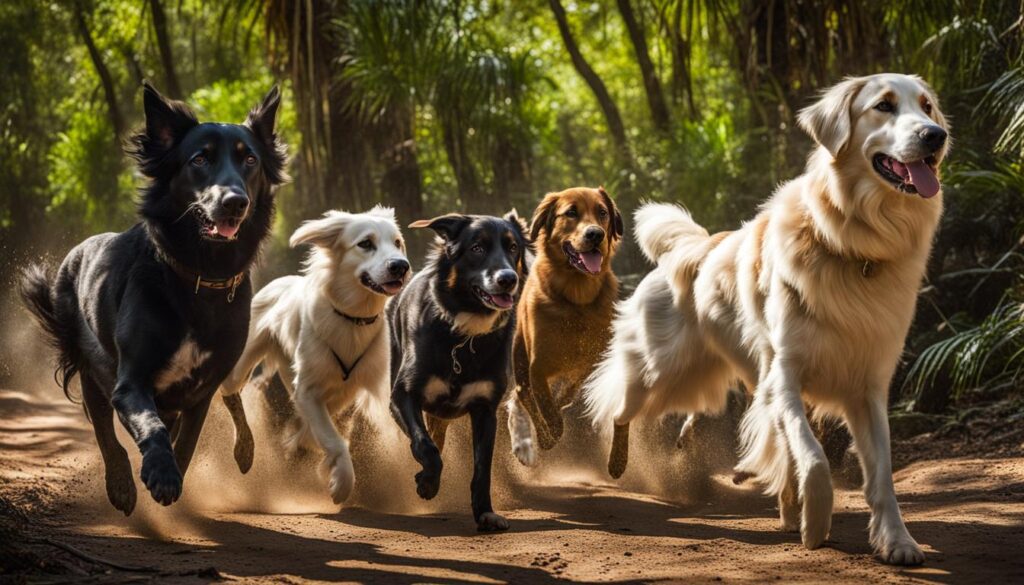
Latin America is home to a diverse landscape of Spanish dog breeds that have spread across the region, embracing the influences of their diverse climates and cultures. This section shines a light on some of these captivating breeds and showcases how their Spanish names are closely tied to their unique personalities and physical attributes.
Diving Into the Diverse Landscape of Latin American Dog Breeds
From the muscle-bound Uruguayan Cimarron to the mighty Argentine Dogo, Latin America is home to a plethora of dog breeds that have captured the hearts of local dog lovers. The following table provides a glimpse into some of the most popular Latin American dog breeds and their native countries.
| Breed Name in Spanish | Country of Origin |
|---|---|
| Cimarrón Uruguayo | Uruguay |
| Dogo Argentino | Argentina |
| Fila Brasileiro | Brazil |
| Perro sin Pelo del Perú | Peru |
| Xoloitzcuintle | Mexico |
How Spanish Dog Breeds Names Reflect Their Personality
The dog breed names in Spanish often mirror the traits and characteristics that make each breed unique. These names evoke a sense of strength, loyalty, or playfulness, offering insights into why a particular Spanish name may be a perfect fit for your pet. For example, the Cimarrón Uruguayo translates to “Uruguayan Wild Dog,” highlighting the breed’s natural strength and adaptability, while the Dogo Argentino, or Argentine Dog, showcases its Argentine roots and the qualities of a powerful, protective guardian.
Across Latin America, dog breeds are celebrated not only for their physical prowess or inherent traits but also for the distinctive names that have been inspired by their origins, histories, and characteristics. By understanding the etymology behind these Spanish breed names, dog owners can appreciate the deep-rooted connections with the diverse cultures of Latin America and the intrinsic bond between man and his best friend.
A Visual Insight: Spanish Dog Breeds Images and Their Impact
Visual representations of Spanish dog breeds play a crucial role in enhancing recognition and popularity. Engaging images of these breeds not only help enthusiasts understand their physical distinctions but also support learning their Spanish names. In this section, we offer visual insights that complement the textual breed descriptions, emphasizing the influence of dog breed images on our perception and understanding of these magnificent canines.
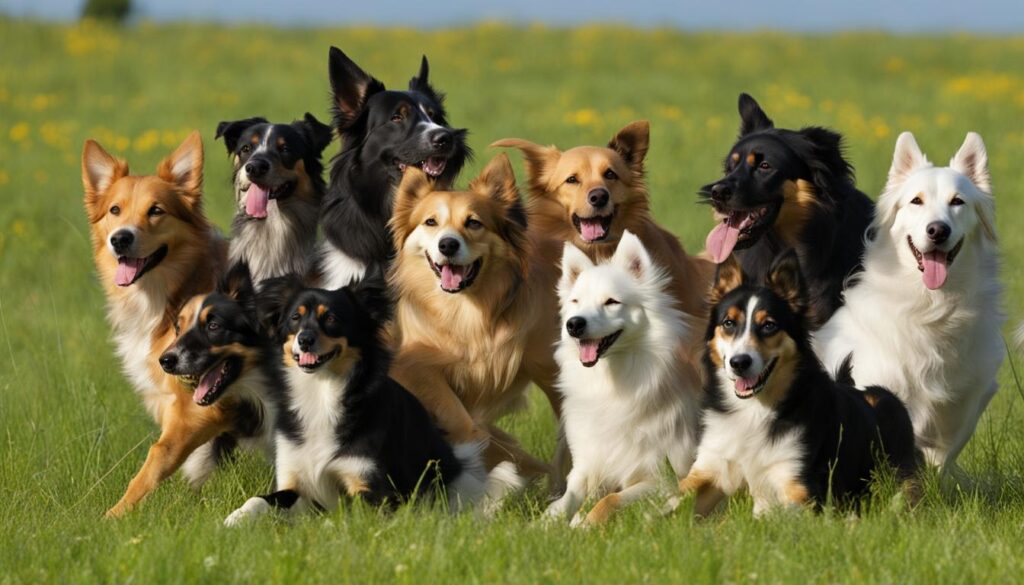
When it comes to the influence of dog breed images, a picture is worth a thousand words. Photographs and illustrations capturing the essence of a breed provide invaluable context and details that may otherwise be missed in a text description. Visualizations make it easier to identify various breeds and their characteristics, enabling a deeper appreciation of their unique features and heritage.
As an example, let’s take a closer look at some popular Spanish dog breeds, highlighting their distinct traits and the impact of their visuals:
| Dog Breed | Notable Features | Visual Impact |
|---|---|---|
| Spanish Mastiff | Large size, strong and muscular build, thick double coat of fur | Impressive size and physique are immediately evident, showcasing the breed’s strength and dominance |
| Catalan Sheepdog | Medium size, shaggy coat, friendly expression | Warm, gentle demeanor reflected in the dog’s appearance, highlighting its suitability as a family pet |
| Presa Canario | Large size, square head, muscular build, short coat | Powerful presence conveys the breed’s confidence and capability as a guardian and protector |
Visual aids such as images and illustrations of Spanish dog breeds serve as an invaluable resource for enthusiasts seeking a deeper understanding of these canines. Photographs are particularly effective in capturing the breed’s physical appearance and demeanor, providing essential context for those interested in their traits and heritage.
In conclusion, the addition of Spanish dog breeds images greatly enhance our understanding of these remarkable animals and their respective traits, bridging the gap between text descriptions and real-life perceptions. Embrace the power of visuals to learn more about these fascinating breeds and appreciate the influence of dog breed images in the world of canine connoisseurship.
The Comprehensive Spanish Dog Breeds List
Spanning from the tiny Chihuahua to the powerful Dogo Argentino, this exhaustive list of Spanish dog breeds covers the extensive variety of canines originating from Spain and Latin America. Discover their unique names and the etymology that defines them, offering a broad perspective on the naming conventions across different Spanish-speaking regions.
From Chihuahua to Dogo Argentino: Naming the Full Spectrum
Below is a comprehensive Spanish dog breeds list, showcasing the wide array of canines from the Chihuahua to the mighty Dogo Argentino. Each breed demonstrates the rich diversity present in Spain and Latin America, emphasizing the unique characteristics and features that set them apart.
- Chihuahua
- Spanish Water Dog
- Catalan Sheepdog
- Spanish Mastiff
- Spanish Greyhound
- Pyrenean Mastiff
- Andalusian Hound
- Galgo Español
- Ibizan Hound
- Majorca Ratter
- Spanish Pointer
- Canarian Warren Hound
- Bodeguero Andaluz
- Spanish Alano
- Pyrenean Shepherd
- Portuguese Podengo
- Peruvian Hairless Dog
- Mexican Hairless Dog
- Uruguayan Cimarron
- Dogo Argentino
The table below provides additional insights into each breed, including the country of origin, size, and primary purpose among others. This information is invaluable for understanding the distinctions between the breeds and their unique characteristics.
| Breed | Country of Origin | Size | Primary Purpose |
|---|---|---|---|
| Chihuahua | Mexico | Small | Companion |
| Spanish Water Dog | Spain | Medium | Herding, Water Work |
| Catalan Sheepdog | Spain | Medium | Herding |
| Spanish Mastiff | Spain | Large | Guarding, Herding |
| Spanish Greyhound | Spain | Large | Hunting, Racing |
| Pyrenean Mastiff | Spain | Large | Guarding, Herding |
| Andalusian Hound | Spain | Medium | Hunting |
| Galgo Español | Spain | Large | Hunting, Racing |
| Ibizan Hound | Spain | Large | Hunting |
| Majorca Ratter | Spain | Small | Vermin Control |
| Spanish Pointer | Spain | Large | Gundog – Pointing |
| Canarian Warren Hound | Canary Islands | Medium | Hunting |
| Bodeguero Andaluz | Spain | Small | Vermin Control |
| Spanish Alano | Spain | Large | Herding, Guarding |
| Pyrenean Shepherd | France, Spain | Small | Herding |
| Portuguese Podengo | Portugal | Small to Medium | Hunting |
| Peruvian Hairless Dog | Peru | Small to Large | Companion |
| Mexican Hairless Dog | Mexico | Small to Large | Companion |
| Uruguayan Cimarron | Uruguay | Large | Guarding |
| Dogo Argentino | Argentina | Large | Hunting, Guarding |
This comprehensive Spanish dog breeds list serves as a valuable resource for discerning the fascinating array of canines hailing from Spain and Latin America. Familiarize yourself with these remarkable breeds, and appreciate the diversity found within the precious world of man’s best friend.
Key Insights on Spanish Dog Breeds Information
Gaining insights on Spanish dog breeds allows dog enthusiasts and prospective pet owners to make informed decisions when selecting their next furry companion. This section will delve into common standards and physical descriptions of popular Spanish dog breeds, equipping you with essential Spanish dog breeds information and data on dog breeds. By understanding the top types of dogs in the Spanish lexicon and navigating cultural considerations when discussing canines in Spanish-speaking environments, you can expand your knowledge on this fascinating subject.
Each Spanish dog breed has specific standards and physical traits which make them unique. These attributes can vary from the dog’s size, coat type, temperament, and general purpose within the breed. Understanding these characteristics can help you identify the breed and appreciate its history and cultural significance.
- Andalusian Hounds are slender and agile, known for their hunting prowess.
- Catalan Sheepdogs are medium-sized with a thick, wavy coat that protects them from the elements while herding livestock.
- Spanish Mastiffs are powerful and large, traditionally bred to guard livestock against predators.
- Basque Shepherds are highly intelligent and energetic, with a medium-length coat that comes in various shades of reddish-brown.
- Spanish Water Dogs have curly, woolly coats and webbed feet, designed for working in aquatic environments.
Top Types of Dogs in the Spanish Lexicon
| Spanish Dog Breed | Primary Function | Average Size |
|---|---|---|
| Andalusian Hound | Hunting | Medium |
| Catalan Sheepdog | Herding | Medium |
| Spanish Mastiff | Guarding | Large |
| Basque Shepherd | Herding | Medium |
| Spanish Water Dog | Water Work | Medium |
Cultural Considerations for Discussing Canines
When discussing Spanish dog breeds in a Spanish-speaking environment, it is essential to consider cultural nuances. For instance, some breeds may have different names within Spain and Latin America, so it’s crucial to use the appropriate terminology accordingly. Additionally, understanding a breed’s historical significance and its role within Spanish culture can lead to a more profound appreciation and respect for the breed as a whole.
Learning the Ropes: How to Best Use This Guide for Naming Your Pet
Choosing the perfect Spanish name for your dog can be an exciting and meaningful process. Our comprehensive guide aims to make this experience easy and enjoyable, providing you with the necessary tools for selecting a unique and fitting name. By understanding the connection between Spanish dog breeds, their characteristics, and their cultural significance, you’ll be prepared to make an informed decision when it comes to naming your furry friend.
When using this guide for naming pets, remember to consider your dog’s distinct personality and attributes. Whether they’re a small and feisty Chihuahua or a loyal and protective Spanish Mastiff, their name should complement their individual nature. This not only strengthens the bond you share with your pet but also fosters a sense of belonging and acknowledges their unique contributions to your family and home.
Incorporating the pet naming tips provided throughout our guide will empower you to choose a suitable name that aligns with the values and traditions of the Spanish-speaking world. So whether you want to engage in Spanish language conversations about your dog, use Spanish commands during training, or simply appreciate the cultural significance of their name, you’ll be equipped with the knowledge and resources to make a well-informed choice. Embrace these insights to honor your canine companion with a name that perfectly captures their essence, and welcomes them into your heart and home.

